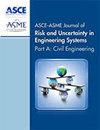美国邻近地区天然气管道的地震风险及其不确定性来源
IF 2.7
3区 工程技术
Q2 ENGINEERING, CIVIL
Asce-Asme Journal of Risk and Uncertainty in Engineering Systems Part A-Civil Engineering
Pub Date : 2022-03-01
DOI:10.1061/ajrua6.0001202
引用次数: 6
摘要
相对而言,很少有研究系统地量化美国全国范围内天然气管道的地震风险;同时,对于全国各地的运营商来说,在持续评估其资产的地震风险方面,国家指导是有限的。此外,天然气管道地震综合风险评估还存在许多挑战和不确定性。作为系统的全国评估的第一阶段,我们量化了美国邻近地区由于强烈的地面震动而导致的天然气输送管道的地震风险,包括相关的不确定性。具体而言,我们整合了美国地质调查局2018年国家地震灾害模型、基于逻辑树的暴露模型、三种不同的脆弱性模型和后果模型。结果可以与其他风险评估工作进行比较,鼓励对替代方法进行更透明的审议,并促进对需要特定地点数据的地面故障造成的局部风险进行潜在评估的决策。在此基础上,对脆弱性模型的敏感性分析表明,脆弱性模型是影响最大的不确定性来源。最后,我们强调了研究需求,如:(i)为天然气管道的区域地震风险评估开发更多的脆弱性模型,(ii)识别、优先排序和测量对估计地震损害很重要的输入管道属性,以及(iii)更好地量化地震灾害及其在国家尺度上的不确定性,包括地面失效和地面震动。本文章由计算机程序翻译,如有差异,请以英文原文为准。
Earthquake Risk of Gas Pipelines in the Conterminous United States and Its Sources of Uncertainty
Relatively little research has been conducted to systematically quantify the nationwide earthquake risk of gas pipelines in the United States; simultaneously, national guidance is limited for operators across the country to consistently evaluate earthquake risk of their assets. Furthermore, many challenges and uncertainties exist in a comprehensive seismic risk assessment of gas pipelines. As a first stage in a systematic nationwide assessment, we quantify the earthquake risk of gas transmission pipelines in the conterminous United States due to strong ground shaking, including the associated uncertainties. Specifically, we integrate the U.S. Geological Survey 2018 National Seismic Hazard Model, a logic tree-based exposure model, three different vulnerability models, and a consequence model. The results enable comparison against other risk assessment efforts, encourage more transparent deliberation regarding alternative approaches, and facilitate decisions on potentially assessing localized risks due to ground failures that require site-specific data. Based on the uncertainties approximated herein, the resulting sensitivity analyses suggest that the vulnerability model is the most influential source of uncertainty. Finally, we highlight research needs such as (i) developing more vulnerability models for regional seismic risk assessment of gas pipelines, (ii) identifying, prioritizing, and measuring input pipeline attributes that are important for estimating seismic damage, and (iii) better quantifying seismic hazards with their uncertainties at the national scale, for both ground failures and ground shaking.
求助全文
通过发布文献求助,成功后即可免费获取论文全文。
去求助
来源期刊

Asce-Asme Journal of Risk and Uncertainty in Engineering Systems Part A-Civil Engineering
Engineering-Building and Construction
CiteScore
5.30
自引率
8.00%
发文量
86
期刊介绍:
The journal will meet the needs of the researchers and engineers to address risk, disaster and failure-related challenges due to many sources and types of uncertainty in planning, design, analysis, construction, manufacturing, operation, utilization, and life-cycle management of existing and new engineering systems. Challenges abound due to increasing complexity of engineering systems, new materials and concepts, and emerging hazards (both natural and human caused). The journal will serve as a medium for dissemination of research findings, best practices and concerns, and for the discussion and debate on risk and uncertainty related issues. The journal will report on the full range of risk and uncertainty analysis state-of-the-art and state-of-the-practice relating to civil and mechanical engineering including but not limited to:
• Risk quantification based on hazard identification,
• Scenario development and rate quantification,
• Consequence assessment,
• Valuations, perception, and communication,
• Risk-informed decision making,
• Uncertainty analysis and modeling,
• Other related areas.
Part A of the journal, published by the American Society of Civil Engineers, will focus on the civil engineering aspects of these topics. Part B will be published by the American Society of Mechanical Engineers focusing on mechanical engineering.
 求助内容:
求助内容: 应助结果提醒方式:
应助结果提醒方式:


